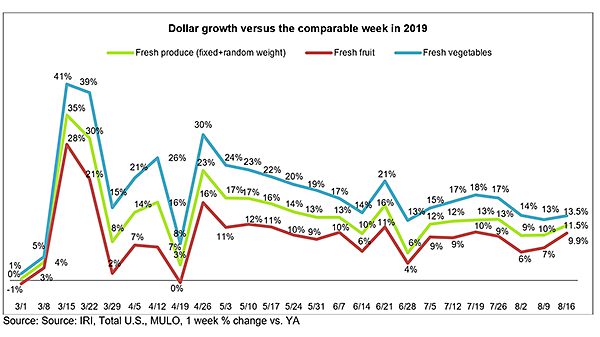
Editor’s note: click charts to enlarge.
Five months after two of the biggest weeks in the history of food retailing, consumer demand for fresh, frozen and center-store food and beverages continues to ride well above the 2019 baseline. The week ending August 16 was the sixth of eight non-holiday weeks between Independence Day and Labor Day and everyday demand easily exceeded year ago levels across departments. New COVID-19 cases started to moderate in many states and the federal unemployment benefit that expired at the end of July was extended, albeit at a lower amount than previously.
Between January and August 16, produce sales in calendar year 2020 are $4.5 billion ahead of 2019 sales, with an additional 2.9 billion pounds of fresh produce sold. Fresh produce appears to be settling into an everyday demand pattern that sits about 10% above last year’s levels. For the week of August 16, fresh fruit and vegetable sales increased 11.5% over 2019 — jumping back into double-digit increases.
Frozen fruits and vegetables had a much higher percentage increase, but the smallest of the three temperature zones. Year-to-date through August, fresh produce department sales are up 11.2% over the same time period in 2019. Frozen fruit and vegetables increased the most, up 27.2% year-to-date. Gains for shelf-stable fruits and vegetables were lower than that of fresh driven down primarily by a single-digit (+7.9%) growth for shelf-stable fruit while veg performed strong yet again.

“While we no longer have the incredible spikes of the shelter-in-place weeks, fresh produce sales are still considerably higher than pre-pandemic levels,” said Joe Watson, VP of Membership and Engagement for the Produce Marketing Association (PMA). “During the upcoming weeks, we will keep a close eye on snackable items to see how the very different back-to-school picture will impact fresh produce sales. Highlighting the availability of healthy fruit and vegetable snacks regardless of virtual or in-person education is a great way to help parents navigate the start of the school year.”
Fresh Produce
Fresh produce generated $1.34 billion in sales the week ending August 16 — an additional $139 million in fresh produce sales over the prior year. This is below the pandemic average for additional dollars, at $176 million per week, as everyday demand continues to see a bit of a slow erosion week to week.
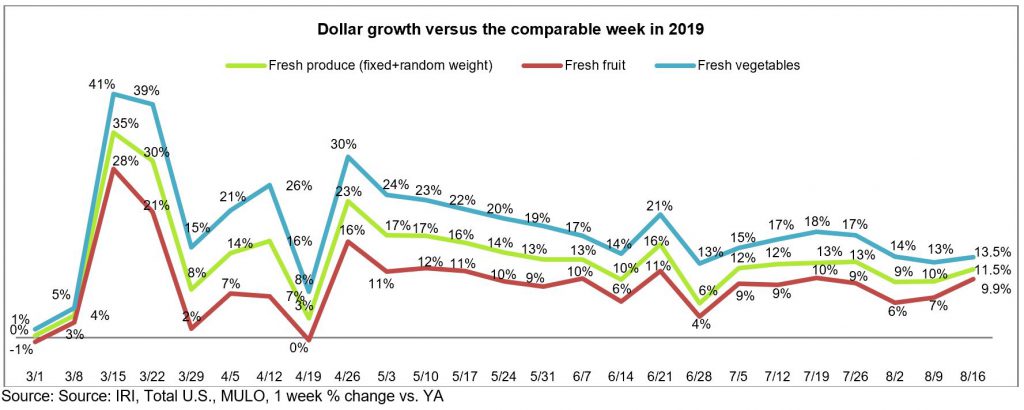
“During the week of August 16, we saw a strong performance of summer fruits and the smallest performance gap between fruit and vegetables we have seen in a long time, at just 3.6 percentage points,” said Jonna Parker, Team Lead Fresh for IRI. “Impulse has a greater impact on fruit sales than vegetables and figuring out ways to optimize visibility and shop-ability for fruit is key to success. Additionally, we see a lot more fluctuation in fruit categories’ contribution to sales than there is in vegetables where tomatoes and lettuce are the top categories week after week. So having the right fruit items, at the right price, with optimal merchandising is important.”
Fresh Share
The fresh produce share of total fruit and vegetable sales across all three temperature zones was 81.9% during the week ending August 16. After falling to as low as 70% of total fruit and vegetable dollars across temperature zones, the fresh share had made a full comeback to its typical 84% during Independence Day week — a big week for fresh produce.
“Frozen fruit and vegetable sales have shown a consistency that point to a potential lasting increase in market share,” said Parker. “Frozen foods in general have been extremely strong and sales increases are generated with many fewer items due to persistent out-of-stocks and SKU rationalization, particularly in frozen fruit.”

Fresh Produce Dollars versus Volume
Ever since the week of May 24th, dollar gains have outpaced volume gains and the week of August 16 was no exception. This week had strong volume gains, closing the volume/dollar gap to just 2.6 percentage points overall. However, inflation and deflation across categories are balancing each other out for the total department view, and at the category level, substantial gaps remain.
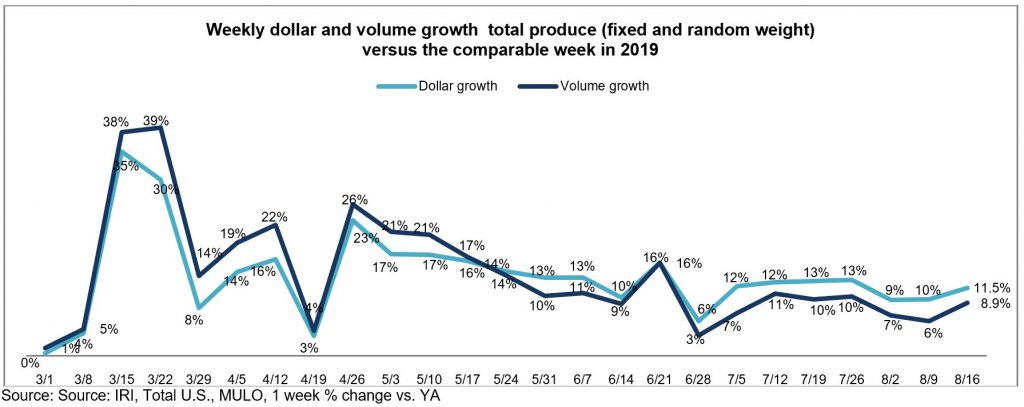
Both fruit and vegetables saw dollar sales gains track ahead of volume gains. Fruit volume gains were significantly higher than those seen the past few weeks, at +7.3% over the same week last year. Vegetable volume growth remained in double digits during the week ending August 16.

While overall produce inflation was relatively mild at +2.4% versus 2019, supply and demand imbalance caused double digit gaps in dollar gains and volume gains in either direction. Ample supply drove double-digit deflation for items such as pomegranates, avocados and pineapples. On the other hand, dollar gains far outpaced volume due to double-digit inflation for items such as apricots, mangoes and berries.

Absolute Dollar Gains
During the week of August 16, berries became the new number one in terms of absolute dollar gains versus the same week year ago. The top 10 in absolute dollar gains completely changed from the week prior yet again. Taking over from cherries, berries contributed $19.6 million in new sales versus year ago as the number one in absolute dollar gains. Cherries dropped to second with a gain of $16.1 million. Lettuce was third with an additional $15.9 million.
“The top 10 in absolute dollar gains shows how much sales contributions can change each week,” said Watson. “This is one of the strongest weeks for summer fruits we have seen all season, with berries, cherries and melons in the number one, two and four slots. This is only the second time that oranges did not make the top 10 in gains, though sales increased 24.5% over the same week year ago. One very important thing to track is whether online sales are reflective of these same kinds of shifts to make sure e-commerce consumers are aware of the summer fruit offering and partaking at the same level as in-store shoppers.”

Fresh Fruit
“In fruit, berries and melons dominated total weekly sales the week of August 16 with big gains over year ago sales,” said Parker. “Other categories, including grapes, apples, bananas and peaches are clearly sales powerhouses and yet they are falling behind 2019 sales levels. Many of these are negatively impacted by deflation as evidenced by strong volume gains for all but grapes. For instance, apple volume is up 0.9% versus year ago, yet dollars are off by 4.0%.”
During the week of August 16, double-digit gains in the top 10 sellers were reserved for berries, melons, cherries, tangerines and oranges.
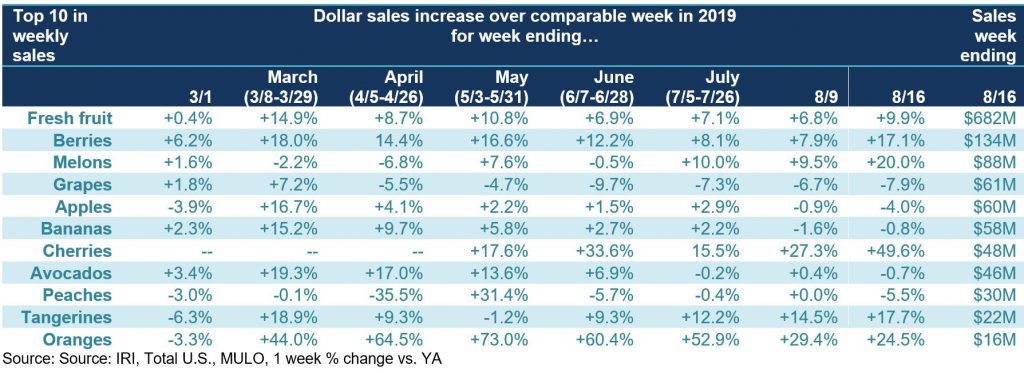
Fresh Vegetables
While fruit sales gains were a mix of double-digit, single-digit and negative growth, all top 10 vegetables increased in dollar sales versus year ago and eight in 10 did so with double-digit gains.
The order and items in the top 10 sellers was unchanged from the prior week. Lettuce was the dominant seller, more than twice the size of number two, tomatoes, yet up 10.5% versus the same week year ago. “Salad bars remain closed for the majority of retailers,” said Watson. “Throughout the pandemic, lettuce, tomatoes, cucumbers and other salad staples have done extremely well perhaps offsetting some of the lost salad bar business.”
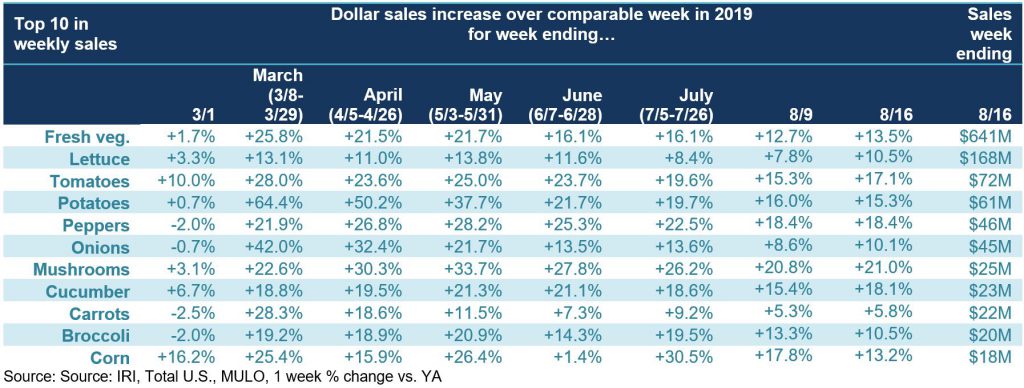
A big part of total lettuce sales was made up by fresh-cut (packaged) salad. Dollar gains for fresh cut salad jumped back into double digits, at +10.3% versus year ago levels. Volume sales increased 6.9%. Volume gains tracked slightly below unit gains, that were up 7.2%. The average price per volume for fresh-cut salad was up 3.2% over year ago levels during the week of August 16.

Fresh Versus Frozen and Shelf-Stable Fruits and Vegetables
The week of August 16 saw a pandemic first, with two areas of fruit and vegetables in single digits versus the same week year ago: fresh fruit and shelf-stable fruit. Frozen fruit gains continued to sit well ahead of last year’s levels, at +35.3%.

Floral
While back in the high single digits, floral sales at retail had another strong week, up 8.0% over the same week last year. With the exception of the week of May 17, sales have been in positive territory since early May.
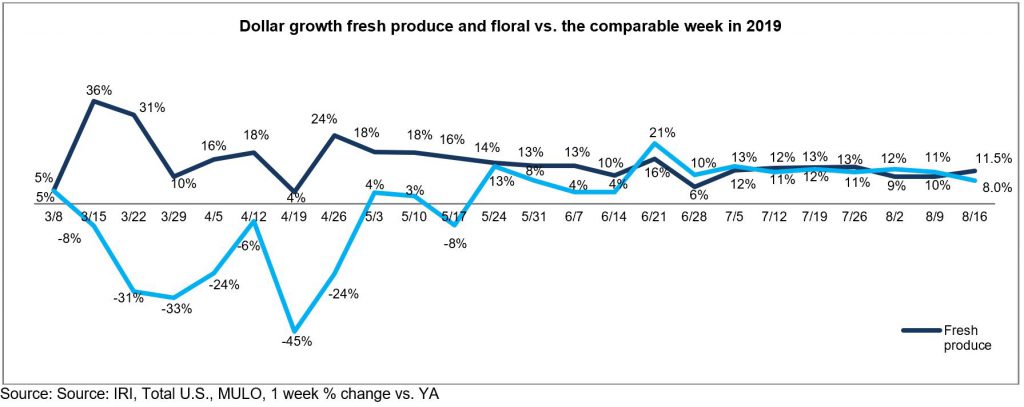
Perimeter Performance
The fresh perimeter once more held its own with gains slightly exceeding those of total store during the week of August 16. Total store sales increased 9.7%, center store gains were 12.8% and the total fresh perimeter improved dollars 10.2% over year ago levels. The strong fresh perimeter performance was driven by above-average meat and seafood sales. Total deli, which encompasses non-UPC, random-weight deli cheese, meat and prepared foods, remained pressured, due to deli-prepared sales’ continued struggles.
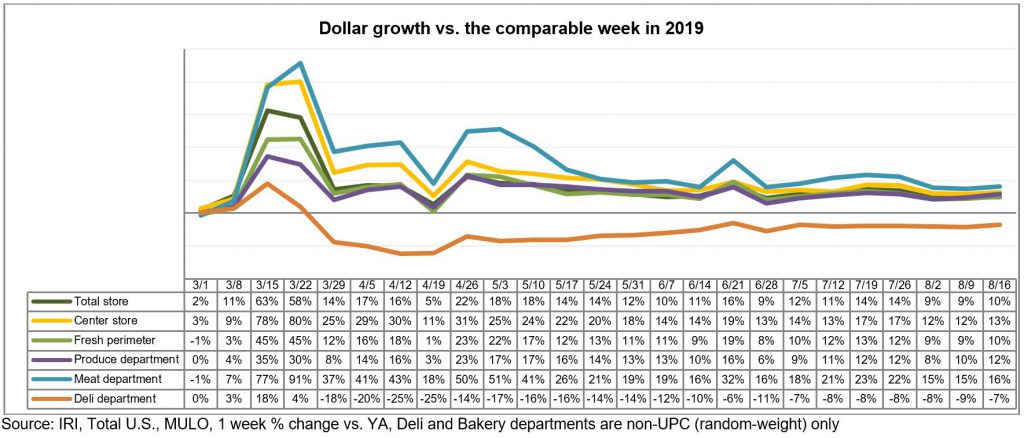
What’s Next?
Both consumer concern and economic pressure remain high, but seem stable for the moment. The economic pressure typically expresses itself in a greater search for value, whether promotions, private brands, cheaper kinds or less fruits and vegetables. Another shift consumers tend to make during difficult economic times is from fresh to frozen and/or canned. Back-to-school season is in full swing, though it looks very differently from prior years in most states. This will continue to impact year-over-year trend lines, particularly for fruits and vegetables commonly used in lunch boxes for the snack and lunch occasions with many more children participating in virtual education from their homes.
Between the continued social distancing mandates, highly elevated consumer concern about the virus, economic pressure and the impact of virtual schooling, produce sales are likely to hold well above 2019 levels for the foreseeable future.
Please recognize the continued dedication of the entire grocery and produce supply chains, from farm to retailer, on keeping the produce supply flowing during these unprecedented times. #produce #joyoffresh #SupermarketSuperHeroes. 210 Analytics and IRI will continue to provide weekly updates as sales trends develop, made possible by PMA. We encourage you to contact Joe Watson, PMA’s Vice President of Membership and Engagement, at jwatson@pma.com with any questions or concerns.
Editor’s note: click charts to enlarge.
Five months after two of the biggest weeks in the history of food retailing, consumer demand for fresh, frozen and center-store food and beverages continues to ride well above the 2019 baseline. The week ending August 16 was the sixth of eight non-holiday weeks between Independence Day and Labor Day and everyday demand easily exceeded year ago levels across departments. New COVID-19 cases started to moderate in many states and the federal unemployment benefit that expired at the end of July was extended, albeit at a lower amount than previously.
Between January and August 16, produce sales in calendar year 2020 are $4.5 billion ahead of 2019 sales, with an additional 2.9 billion pounds of fresh produce sold. Fresh produce appears to be settling into an everyday demand pattern that sits about 10% above last year’s levels. For the week of August 16, fresh fruit and vegetable sales increased 11.5% over 2019 — jumping back into double-digit increases.
Frozen fruits and vegetables had a much higher percentage increase, but the smallest of the three temperature zones. Year-to-date through August, fresh produce department sales are up 11.2% over the same time period in 2019. Frozen fruit and vegetables increased the most, up 27.2% year-to-date. Gains for shelf-stable fruits and vegetables were lower than that of fresh driven down primarily by a single-digit (+7.9%) growth for shelf-stable fruit while veg performed strong yet again.

“While we no longer have the incredible spikes of the shelter-in-place weeks, fresh produce sales are still considerably higher than pre-pandemic levels,” said Joe Watson, VP of Membership and Engagement for the Produce Marketing Association (PMA). “During the upcoming weeks, we will keep a close eye on snackable items to see how the very different back-to-school picture will impact fresh produce sales. Highlighting the availability of healthy fruit and vegetable snacks regardless of virtual or in-person education is a great way to help parents navigate the start of the school year.”
Fresh Produce
Fresh produce generated $1.34 billion in sales the week ending August 16 — an additional $139 million in fresh produce sales over the prior year. This is below the pandemic average for additional dollars, at $176 million per week, as everyday demand continues to see a bit of a slow erosion week to week.

“During the week of August 16, we saw a strong performance of summer fruits and the smallest performance gap between fruit and vegetables we have seen in a long time, at just 3.6 percentage points,” said Jonna Parker, Team Lead Fresh for IRI. “Impulse has a greater impact on fruit sales than vegetables and figuring out ways to optimize visibility and shop-ability for fruit is key to success. Additionally, we see a lot more fluctuation in fruit categories’ contribution to sales than there is in vegetables where tomatoes and lettuce are the top categories week after week. So having the right fruit items, at the right price, with optimal merchandising is important.”
Fresh Share
The fresh produce share of total fruit and vegetable sales across all three temperature zones was 81.9% during the week ending August 16. After falling to as low as 70% of total fruit and vegetable dollars across temperature zones, the fresh share had made a full comeback to its typical 84% during Independence Day week — a big week for fresh produce.
“Frozen fruit and vegetable sales have shown a consistency that point to a potential lasting increase in market share,” said Parker. “Frozen foods in general have been extremely strong and sales increases are generated with many fewer items due to persistent out-of-stocks and SKU rationalization, particularly in frozen fruit.”

Fresh Produce Dollars versus Volume
Ever since the week of May 24th, dollar gains have outpaced volume gains and the week of August 16 was no exception. This week had strong volume gains, closing the volume/dollar gap to just 2.6 percentage points overall. However, inflation and deflation across categories are balancing each other out for the total department view, and at the category level, substantial gaps remain.

Both fruit and vegetables saw dollar sales gains track ahead of volume gains. Fruit volume gains were significantly higher than those seen the past few weeks, at +7.3% over the same week last year. Vegetable volume growth remained in double digits during the week ending August 16.

While overall produce inflation was relatively mild at +2.4% versus 2019, supply and demand imbalance caused double digit gaps in dollar gains and volume gains in either direction. Ample supply drove double-digit deflation for items such as pomegranates, avocados and pineapples. On the other hand, dollar gains far outpaced volume due to double-digit inflation for items such as apricots, mangoes and berries.

Absolute Dollar Gains
During the week of August 16, berries became the new number one in terms of absolute dollar gains versus the same week year ago. The top 10 in absolute dollar gains completely changed from the week prior yet again. Taking over from cherries, berries contributed $19.6 million in new sales versus year ago as the number one in absolute dollar gains. Cherries dropped to second with a gain of $16.1 million. Lettuce was third with an additional $15.9 million.
“The top 10 in absolute dollar gains shows how much sales contributions can change each week,” said Watson. “This is one of the strongest weeks for summer fruits we have seen all season, with berries, cherries and melons in the number one, two and four slots. This is only the second time that oranges did not make the top 10 in gains, though sales increased 24.5% over the same week year ago. One very important thing to track is whether online sales are reflective of these same kinds of shifts to make sure e-commerce consumers are aware of the summer fruit offering and partaking at the same level as in-store shoppers.”

Fresh Fruit
“In fruit, berries and melons dominated total weekly sales the week of August 16 with big gains over year ago sales,” said Parker. “Other categories, including grapes, apples, bananas and peaches are clearly sales powerhouses and yet they are falling behind 2019 sales levels. Many of these are negatively impacted by deflation as evidenced by strong volume gains for all but grapes. For instance, apple volume is up 0.9% versus year ago, yet dollars are off by 4.0%.”
During the week of August 16, double-digit gains in the top 10 sellers were reserved for berries, melons, cherries, tangerines and oranges.

Fresh Vegetables
While fruit sales gains were a mix of double-digit, single-digit and negative growth, all top 10 vegetables increased in dollar sales versus year ago and eight in 10 did so with double-digit gains.
The order and items in the top 10 sellers was unchanged from the prior week. Lettuce was the dominant seller, more than twice the size of number two, tomatoes, yet up 10.5% versus the same week year ago. “Salad bars remain closed for the majority of retailers,” said Watson. “Throughout the pandemic, lettuce, tomatoes, cucumbers and other salad staples have done extremely well perhaps offsetting some of the lost salad bar business.”

A big part of total lettuce sales was made up by fresh-cut (packaged) salad. Dollar gains for fresh cut salad jumped back into double digits, at +10.3% versus year ago levels. Volume sales increased 6.9%. Volume gains tracked slightly below unit gains, that were up 7.2%. The average price per volume for fresh-cut salad was up 3.2% over year ago levels during the week of August 16.

Fresh Versus Frozen and Shelf-Stable Fruits and Vegetables
The week of August 16 saw a pandemic first, with two areas of fruit and vegetables in single digits versus the same week year ago: fresh fruit and shelf-stable fruit. Frozen fruit gains continued to sit well ahead of last year’s levels, at +35.3%.

Floral
While back in the high single digits, floral sales at retail had another strong week, up 8.0% over the same week last year. With the exception of the week of May 17, sales have been in positive territory since early May.

Perimeter Performance
The fresh perimeter once more held its own with gains slightly exceeding those of total store during the week of August 16. Total store sales increased 9.7%, center store gains were 12.8% and the total fresh perimeter improved dollars 10.2% over year ago levels. The strong fresh perimeter performance was driven by above-average meat and seafood sales. Total deli, which encompasses non-UPC, random-weight deli cheese, meat and prepared foods, remained pressured, due to deli-prepared sales’ continued struggles.

What’s Next?
Both consumer concern and economic pressure remain high, but seem stable for the moment. The economic pressure typically expresses itself in a greater search for value, whether promotions, private brands, cheaper kinds or less fruits and vegetables. Another shift consumers tend to make during difficult economic times is from fresh to frozen and/or canned. Back-to-school season is in full swing, though it looks very differently from prior years in most states. This will continue to impact year-over-year trend lines, particularly for fruits and vegetables commonly used in lunch boxes for the snack and lunch occasions with many more children participating in virtual education from their homes.
Between the continued social distancing mandates, highly elevated consumer concern about the virus, economic pressure and the impact of virtual schooling, produce sales are likely to hold well above 2019 levels for the foreseeable future.
Please recognize the continued dedication of the entire grocery and produce supply chains, from farm to retailer, on keeping the produce supply flowing during these unprecedented times. #produce #joyoffresh #SupermarketSuperHeroes. 210 Analytics and IRI will continue to provide weekly updates as sales trends develop, made possible by PMA. We encourage you to contact Joe Watson, PMA’s Vice President of Membership and Engagement, at jwatson@pma.com with any questions or concerns.
Anne-Marie Roerink is the President of 210 Analytics.
















